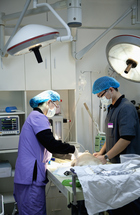Spaying and Neutering
 Spaying and neutering are surgical procedures performed to prevent animals from reproducing. While "neuter" actually means "neither sex" and can theoretically be used to refer to an operation on either gender, in common usage neuter refers to the removal of the male's testicles and spay refers to the removal of the female's uterus, ovaries and fallopian tubes. In horses, the operation on males is known as gelding. For most pet owners, with the exception of professional breeders, spaying or neutering is a wise choice. The simple, safe surgical procedures are not only socially responsible, but beneficial to the animals' health. They will also help to curb certain troublesome behavior patterns.
Spaying and neutering are surgical procedures performed to prevent animals from reproducing. While "neuter" actually means "neither sex" and can theoretically be used to refer to an operation on either gender, in common usage neuter refers to the removal of the male's testicles and spay refers to the removal of the female's uterus, ovaries and fallopian tubes. In horses, the operation on males is known as gelding. For most pet owners, with the exception of professional breeders, spaying or neutering is a wise choice. The simple, safe surgical procedures are not only socially responsible, but beneficial to the animals' health. They will also help to curb certain troublesome behavior patterns.
Benefits of Spaying and Neutering
There are excellent reasons for spaying or neutering, both for the individual animal and for the community. Some result from the elimination of undesired reproduction, others from the elimination of male and female sex hormones, testosterone and estrogen, respectively. The benefits of neutering and spaying apply not only to dogs and cats but to other small mammals, like rabbits, particularly because such creatures multiply so rapidly.
Benefits for the Individual Animal
- Prevents pregnancy
- Reduces spraying behavior
- Reduces the odor of male urine
- Reduces mounting behavior
- Reducing roaming behavior
- Eliminates "heat" cycles in females
- Eliminates diseases of the reproductive tract
- Reduces chance of certain other infections or diseases
- Prevents aggressive behavior
- Increasing probability of longevity
- Lowers long-term cost of pet ownership
Benefits for the Community
- Prevents contributing to overpopulation of pets
- Reduces population of strays and feral animals
- Reduces the need to euthanize healthy animals
- Reduces accidental deaths of animals
- Reduces incidents of biting and attacks
- Reduces public costs of animal capture, care, euthanasia
Once an animal has been altered, it has a much greater chance of leading a longer, healthier life. In addition, responsible pet owners who make the choice to have their animals spayed or neutered are ensuring that the population of animals doomed to misery and early death declines. Overpopulation of stray animals is an enormous problem. At present, approximately 3 million healthy, adoptable pets are destroyed annually.
Spaying and Neutering Procedures
 Pets should be spayed or neutered early in their lives, usually by about 6 months of age. While the procedures can be performed later in life, the recovery is usually more complicated when the animal is older. Spaying and neutering are performed under general anesthesia. They are safe, well-tested surgeries from which young animals recover quickly.
Pets should be spayed or neutered early in their lives, usually by about 6 months of age. While the procedures can be performed later in life, the recovery is usually more complicated when the animal is older. Spaying and neutering are performed under general anesthesia. They are safe, well-tested surgeries from which young animals recover quickly.
Normally, animals can return home the day after the procedure and are completely back to themselves within a week or two. Because it is important that the pet does not lick or scratch the incision site, some animals are fitted with cone-shaped collars to prevent interference with the wound and reduce the possibility of infection.
Myths About Spaying and Neutering
It is important to dispel the following myths about spaying and neutering in order to prevent the proliferation of unwanted, neglected, and euthanized pets.
In the interests of raising a healthy pet with as long a life span as possible, and of preventing misery for countless unborn creatures, spaying and neutering are the rational and compassionate choice.The Myths
- One should allow a female to have one litter before spaying
- Purebreds should not be spayed or neutered
- Spaying or neutering will make a dog less protective
- The spayed or neutered pet will become fat and lazy
- It is too expensive to have the procedure performed
The Truth
- It is healthier to spay a female before she has a litter
- A great many purebreds end up as strays and are euthanized
- Protective instincts are natural to dogs whether altered or not
- Animals only become fat and lazy if they are overfeed and under-exercised
- Procedures cost far less than diseases and accidents they prevent